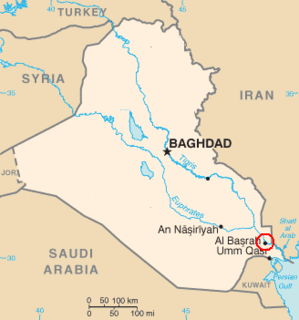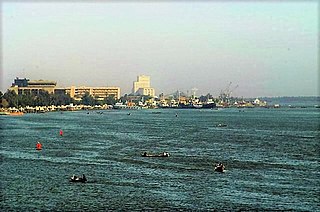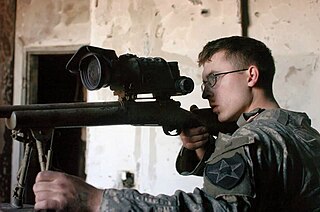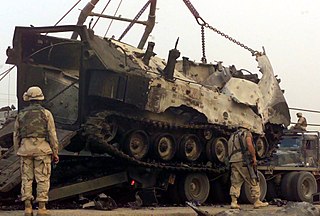 W
WThe 2003 Mosul raid was an American military operation conducted on July 22, 2003, in the city of Mosul, Iraq, which led to the killing of Uday Hussein and Qusay Hussein, both sons of deposed Iraqi dictator Saddam Hussein. The operation, originally intended to apprehend the Hussein brothers, turned into a four-hour gun battle outside a fortified safehouse which ended with the death of both Hussein brothers, a 14-year-old relative, and a bodyguard.
 W
WThe Battle of Hawija was an offensive launched in September 2017 by the Iraqi Army, in order to recapture town of Hawija and the surrounding areas from the Islamic State of Iraq and the Levant (ISIL).
 W
WThe Iraq War in Al Anbar Governorate, also known as the Al Anbar campaign, consisted of fighting between the United States military, together with Iraqi Government forces, and Sunni insurgents in the western Iraqi governorate of Al Anbar. The Iraq War lasted from 2003 to 2011, but the majority of the fighting and counterinsurgency campaign in Anbar took place between April 2004 and September 2007. Although the fighting initially featured heavy urban warfare primarily between insurgents and U.S. Marines, insurgents in later years focused on ambushing the American and Iraqi security forces with improvised explosive devices (IED's), large scale attacks on combat outposts, and car bombings. Almost 9,000 Iraqis and 1,335 Americans were killed in the campaign, many in the Euphrates River Valley and the Sunni Triangle around the cities of Fallujah and Ramadi.
 W
WThe Battle of Baghdad (2003), also known as the Fall of Baghdad, was a military invasion of Baghdad that took place in early April 2003, as part of the invasion of Iraq.
 W
WThe Battle of Baqubah II took place during the Iraq War in the capital of the Iraqi province Diyala, to the north-east of Baghdad. It began in early March 2007, when US and Iraqi forces commenced preliminary operations to "establish a presence in Diyala beyond their Forward Operating Base".
 W
WThe Battle of Basra began on 25 March 2008, when the Iraqi Army launched an operation to drive the Mahdi Army militia out of the southern Iraqi city of Basra. The operation was the first major operation to be planned and carried out by the Iraqi Army since the invasion of 2003.
 W
WThe Battle of Basra lasted from 21 March to 6 April 2003 and was one of the first battles of the 2003 invasion of Iraq. The British 7 Armoured Brigade fought their way into Iraq's second-largest city, Basra, on 6 April coming under constant attack by the Iraqi Army 51st Division and Fedayeen. While elements of the Parachute Regiment cleared the 'old quarter' of the city that was inaccessible to vehicles. Entering Basra had only been achieved after two weeks of conflict, which included the biggest tank battle of the war by British forces when the Royal Scots Dragoon Guards destroyed 14 Iraqi tanks on the 27 March.
 W
WThe First Battle of Fallujah, code-named Operation Vigilant Resolve, was an operation against militants in Fallujah as well as an attempt to apprehend or kill the perpetrators of the killing of four U.S. contractors in March 2004.
 W
WThe Second Battle of Fallujah—code-named Operation Al-Fajr and Operation Phantom Fury—was a joint American, Iraqi government, and British offensive in November and December 2004, considered the highest point of conflict in Fallujah during the Iraq War. It was led by the U.S. Army and U.S. Marines against the Iraqi insurgents in the city of Fallujah and was authorized by the U.S.-appointed Iraqi Interim Government. The U.S. military called it "some of the heaviest urban combat U.S. Marines and Soldiers have been involved in since the Battle of Huế City in Vietnam in 1968."
 W
WThe Battle of Haifa Street was a battle fought during January 2007 for the control of Haifa Street, a two-mile-long street in downtown Baghdad, Iraq, pitting American and Iraqi Army forces against various Sunni insurgent forces between January 6 and January 9, 2007, and then two weeks later on January 24 when US forces launched a second attempt to clear Haifa Street of insurgents once and for all. This battle was the precursor for clearing operations that would set the conditions for "the surge" which ultimately neutralized insurgent groups in this part of Baghdad during the spring and summer of 2007.
 W
WThe Battle of Al Hillah was an armed military confrontation between military elements of the Coalition Provisional Authority and Iraq during the 2003 Invasion of Iraq. Prior to the Iraq War, the ancient city of Al Hillah was home to numerous bases for the Iraqi Medina division of the Iraqi Republican Guard. As a main objective of the invasion of Iraq was to disable the Republican Guard, this made Al Hillah an important target for Coalition forces, as well as the fact that Al Hillah lay in the path of the planned Coalition advance on Najaf.
 W
WThe Battle of Karbala took place during the 2003 invasion of Iraq as U.S. troops fought to clear the city of Iraqi forces. The city had been bypassed during the advance on Baghdad, leaving American units to clear it in two days of street fighting against Iraqi irregular forces.
 W
WThe Battle for Mosul was a battle fought during the Iraq War in 2004 for the capital of the Ninawa Governorate in northern Iraq that occurred concurrently to fighting in Fallujah.
 W
WThe Battle of Najaf was fought between United States and Iraqi forces on one side and the Islamist Mahdi Army of Muqtada al-Sadr on the other in the Iraqi city of Najaf in August 2004.
 W
WThe Battle of Nasiriyah was fought between the US 2nd Marine Expeditionary Brigade and Iraqi forces from 23 March to 2 April 2003 during the US-led invasion of Iraq. Nasiriyah is a city which lies along the banks of the Euphrates River in Dhi Qar Province, about 225 mi (362 km) southeast of Baghdad. Its population is made up almost entirely of Shia Muslims. On the night of 24–25 March, the bulk of the Marines of Regimental Combat Team 1 passed through the city over the bridges and attacked north towards Baghdad. However fighting continued in the city until 1 April when Iraqi resistance in the city was defeated.
 W
WThe Battle of Ramadi in 2006 was fought during the Iraq War from March 2006 to November 2006, for control of the capital of the Al Anbar Governorate in western Iraq. A combined force of U.S. Army Soldiers, U.S. Marines, U.S. Navy SEALs, and Iraqi Security Forces fought insurgents for control of key locations in Ramadi, including the Government Centre which was held by 1st Bn 6th Marines bravo company and the General Hospital. Coalition strategy relied on establishing a number of patrol bases called Combat Operation Posts throughout the city which many where manned by other elements of 1st Bn 6th Marines and some from the army on the outer parts of the city.
 W
WThe Siege of Sadr City was a blockade of the Shi'a district of northeastern Baghdad carried out by U.S. and Iraqi government forces in an attempt to destroy the main power base of the insurgent Mahdi Army in Baghdad. The siege began on 4 April 2004 – later dubbed "Black Sunday" – with an uprising against the Coalition Provisional Authority following the government banning of a newspaper published by Muqtada Al-Sadr's Sadrist Movement. The most intense periods of fighting in Sadr City occurred during the first uprising in April 2004, the second in August the same year, during the sectarian conflict that gripped Baghdad in late 2006, during the Iraq War troop surge of 2007, and during the spring fighting of 2008.
 W
WThe Battle of Samarra, also called Operation Baton Rouge, took place in 2004 during the Iraq War. The city of Samarra in central Iraq had fallen under the control of insurgents shortly after insurgents had seized control of Fallujah and Ramadi. In preparation for an offensive to retake Fallujah, on 1 October, 5,000 American and Iraqi troops assaulted Samarra and secured the city after three days of fighting.
 W
WThe Battle of Tal Afar also known as Operation Restoring Rights was a military offensive conducted by the United States Army and supported by Iraqi forces, to eliminate Al Qaeda in Iraq and other insurgents in the city of Tal Afar, Iraq in response to the increase of insurgent attacks against U.S. and Iraqi positions in the area and to end the brutal tactics against the population by the terrorists. Coalition Forces consisted of 3rd Armored Cavalry Regiment, elements of the 82nd Airborne Division, and two brigades of the Iraqi 3rd Division, all were under the command of Col. H.R. McMaster. AQI had used the city as a staging ground for moving foreign fighters into Iraq since early 2005. The city was temporarily cleared for elections in 2005, but was not secured in a long-term view.
 W
WThe Battle of Umm Qasr was the first military confrontation in the Iraq War. At the start of the war, one of the first objectives was the port of Umm Qasr. On 21 March 2003, as allied forces advanced across Southern Iraq, an amphibious landing force captured the new port area of Umm Qasr. The assault was spearheaded by Royal Marines of the British 3 Commando Brigade, augmented by U.S. Marines of the American 15th MEU and Polish JW GROM troops. Iraqi forces in the old town of Umm Qasr put up unexpectedly strong resistance, requiring several days' fighting before the area was cleared of defenders. The port was finally declared safe and reopened on 25 March 2003.